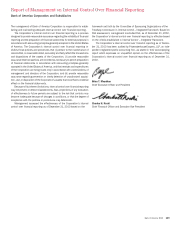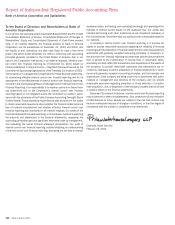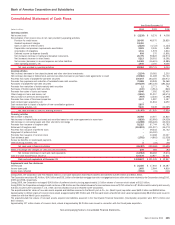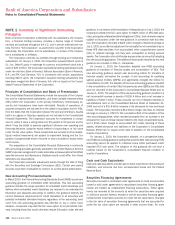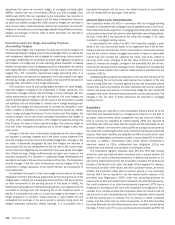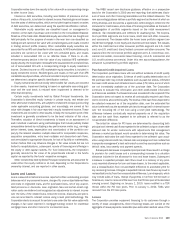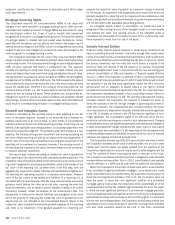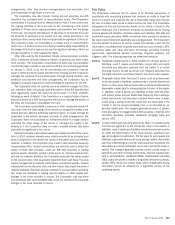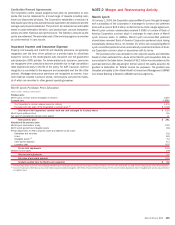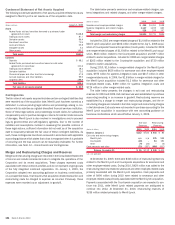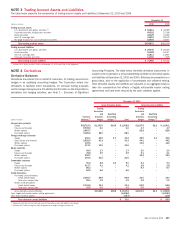Bank of America 2010 Annual Report Download - page 150
Download and view the complete annual report
Please find page 150 of the 2010 Bank of America annual report below. You can navigate through the pages in the report by either clicking on the pages listed below, or by using the keyword search tool below to find specific information within the annual report.derivatives that serve as economic hedges of mortgage servicing rights
(MSRs), interest rate lock commitments (IRLCs) and first mortgage loans
held-for-sale (LHFS) that are originated by the Corporation are recorded in
mortgage banking income. Changes in the fair value of derivatives that serve
as asset and liability management (ALM) economic hedges are recorded in
other income (loss). Credit derivatives used by the Corporation as economic
hedges do not qualify as accounting hedges despite being effective economic
hedges, and changes in the fair value of these derivatives are included in
other income (loss).
Derivatives Used For Hedge Accounting Purposes
(Accounting Hedges)
For accounting hedges, the Corporation formally documents at inception all
relationships between hedging instruments and hedged items, as well as the
risk management objectives and strategies for undertaking various account-
ing hedges. Additionally, the Corporation primarily uses regression analysis at
the inception of a hedge and for each reporting period thereafter to assess
whether the derivative used in a hedging transaction is expected to be and has
been highly effective in offsetting changes in the fair value or cash flows of a
hedged item. The Corporation discontinues hedge accounting when it is
determined that a derivative is not expected to be or has ceased to be highly
effective as a hedge, and then reflects changes in fair value of the derivative in
earnings after termination of the hedge relationship.
The Corporation uses its accounting hedges as either fair value hedges,
cash flow hedges or hedges of net investments in foreign operations. The
Corporation manages interest rate and foreign currency exchange rate sen-
sitivity predominantly through the use of derivatives. Fair value hedges are
used to protect against changes in the fair value of the Corporation’s assets
and liabilities that are attributable to interest rate or foreign exchange vola-
tility. Cash flow hedges are used primarily to minimize the variability in cash
flows of assets or liabilities, or forecasted transactions caused by interest
rate or foreign exchange fluctuations. For terminated cash flow hedges, the
maximum length of time over which forecasted transactions are hedged is
26 years, with a substantial portion of the hedged transactions being less
than 10 years. For open or future cash flow hedges, the maximum length of
time over which forecasted transactions are or will be hedged is less than
seven years.
Changes in the fair value of derivatives designated as fair value hedges
are recorded in earnings, together and in the same income statement line
item with changes in the fair value of the related hedged item. Changes in the
fair value of derivatives designated as cash flow hedges are recorded in
accumulated OCI and are reclassified into the line item in the income state-
ment in which the hedged item is recorded and in the same period the hedged
item affects earnings. Hedge ineffectiveness and gains and losses on the
excluded component of a derivative in assessing hedge effectiveness are
recorded in earnings in the same income statement line item. The Corporation
records changes in the fair value of derivatives used as hedges of the net
investment in foreign operations, to the extent effective, as a component of
accumulated OCI.
If a derivative instrument in a fair value hedge is terminated or the hedge
designation removed, the previous adjustments to the carrying amount of the
hedged asset or liability are subsequently accounted for in the same manner
as other components of the carrying amount of that asset or liability. For
interest-earning assets and interest-bearing liabilities, such adjustments are
amortized to earnings over the remaining life of the respective asset or
liability. If a derivative instrument in a cash flow hedge is terminated or the
hedge designation is removed, related amounts in accumulated OCI are
reclassified into earnings in the same period or periods during which the
hedged forecasted transaction affects earnings. If it is probable that a
forecasted transaction will not occur, any related amounts in accumulated
OCI are reclassified into earnings in that period.
Interest Rate Lock Commitments
The Corporation enters into IRLCs in connection with its mortgage banking
activities to fund residential mortgage loans at specified times in the future.
IRLCs that relate to the origination of mortgage loans that will be held for sale
are considered derivative instruments under applicable accounting guidance.
As such, these IRLCs are recorded at fair value with changes in fair value
recorded in mortgage banking income.
In estimating the fair value of an IRLC, the Corporation assigns a prob-
ability to the loan commitment based on an expectation that it will be exer-
cised and the loan will be funded. The fair value of the commitments is derived
from the fair value of related mortgage loans which is based on observable
market data and includes the expected net future cash flows related to
servicing of the loans. Changes to the fair value of IRLCs are recognized
based on interest rate changes, changes in the probability that the commit-
ment will be exercised and the passage of time. Changes from the expected
future cash flows related to the customer relationship are excluded from the
valuation of IRLCs.
Outstanding IRLCs expose the Corporation to the risk that the price of the
loans underlying the commitments might decline from inception of the rate
lock to funding of the loan. To protect against this risk, the Corporation utilizes
forward loan sales commitments and other derivative instruments, including
interest rate swaps and options, to economically hedge the risk of potential
changes in the value of the loans that would result from the commitments. The
changes in the fair value of these derivatives are recorded in mortgage
banking income.
Securities
Debt securities are recorded on the Consolidated Balance Sheet as of the
trade date and classified based on management’s intention on the date of
purchase. Debt securities which management has the intent and ability to
hold to maturity are classified as held-to-maturity (HTM) and reported at
amortized cost. Debt securities that are bought and held principally for the
purpose of resale in the near term are classified as trading and are carried at
fair value with unrealized gains and losses included in trading account profits
(losses). Other debt securities are classified as AFS and carried at fair value
with net unrealized gains and losses included in accumulated OCI on an after-
tax basis. In addition, credit-related notes, which include investments in
securities issued by CDOs, collateralized loan obligations (CLOs) and
credit-linked note vehicles, are classified as trading securities.
The Corporation regularly evaluates each AFS and HTM debt security
where the value has declined below amortized cost to assess whether the
decline in fair value is other-than-temporary. In determining whether an im-
pairment is other-than-temporary, the Corporation considers the severity and
duration of the decline in fair value, the length of time expected for recovery,
the financial condition of the issuer, and other qualitative factors, as well as
whether the Corporation either plans to sell the security or it is more-likely-
than-not that it will be required to sell the security before recovery of its
amortized cost. Beginning in 2009, under new accounting guidance for
impairments of debt securities that are deemed to be other-than-temporary,
the credit component of an other-than-temporary impairment (OTTI) loss is
recognized in earnings and the non-credit component is recognized in accu-
mulated OCI in situations where the Corporation does not intend to sell the
security and it is not more-likely-than-not that the Corporation will be required
to sell the security prior to recovery. Prior to January 1, 2009, unrealized
losses, both the credit and non-credit components, on AFS debt securities
that were deemed to be other-than-temporary were included in current-period
earnings. If there is an OTTI on any individual security classified as HTM, the
148 Bank of America 2010



